 Leading Blog | Posts by Month |
 Leading Blog | Posts by Month |
01.31.24

LeadershipNow 140: January 2024 Compilation
See more on
Posted by Michael McKinney at 09:12 AM
01.25.24

Leading Thoughts for January 25, 2024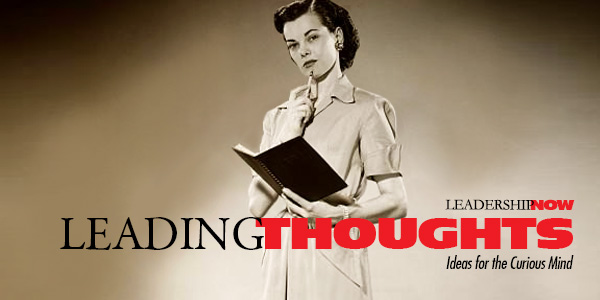
IDEAS shared have the power to expand perspectives, change thinking, and move lives. Here are two ideas for the curious mind to engage with: Shayne Hughes on the toxic habit of being right: “For our ego, the sensation of being right is like electricity to a lightbulb. It fuels us with energy and vigor. We sit straighter, our voice sharpens, and our language hardens. We face an issue or a conflict, and we see the answer clearly. With this certainty comes a feeling of power and righteousness, as captivating as a drug rush. This is the way it is. Being right sweeps us so automatically into an aggressive mental stance that any collateral damage seems just a necessary evil.” Source: Ego Free Leadership: Ending the Unconscious Habits That Hijack Your Business Chris Westfall on the danger of hanging our identity on an outcome: “Human beings are really good at making stuff up. We create plans and projections and proclamations — stories inside our minds about perfect statues and how high expectations are a requirement for high performance. I’m not saying that having goals is completely useless. It’s not. What I’m talking about is our relationship with our goals. We build up all these ‘if/then’ statements: ‘if the doesn’t go for this idea, then I’m a failure. If she doesn’t love me back, I’m a loser. If this doesn’t go exactly the way I’ve scripted and sculpted it out, I’m a disaster.’ Hanging your identity on an outcome is a recipe for defeat. Because the expectation is based on a misunderstanding. Yet we do it all the time!” Source: Easier: 60 Ways to Make Your Work Life Work for You Look for these ideas every Thursday on the Leading Blog. Find more ideas on the LeadingThoughts index.
Posted by Michael McKinney at 12:15 PM
01.19.24

How to Ensure Your Organization’s Digital Transformation Succeeds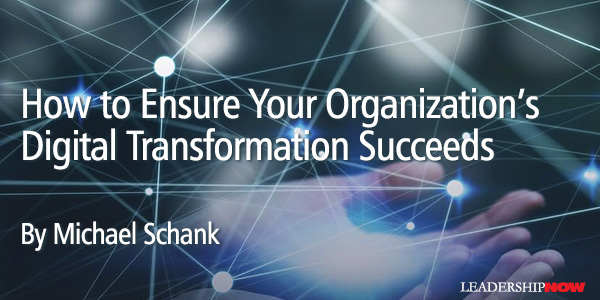
IN THE AGE of digitization, businesses face a critical imperative: to adapt and embrace innovation or risk being left behind in a rapidly evolving world. This force is called creative destruction, which is the process where innovation and technology advancements are reshaping industries and business models. It is reorienting the competitive landscape — winners will flourish while losers will be at a severe competitive disadvantage, losing ground to competitors and frustrating stakeholders and customers. To illustrate the potential impacts, in 2007, Nokia had a little over half the mobile phone market with an operating profit of about $7.8 billion. That same year, Apple introduced the iPhone, which revolutionized the industry with its superior touchscreen interface and robust app ecosystem. Nokia just couldn’t keep up. Its phones were quickly viewed as antiquated and difficult to work with for developers. Subsequently, its market share plummeted by 90 percent. In 2013, Nokia’s mobile phone business was sold to Microsoft. A post-mortem was conducted that pointed to a lack of organizational alignment, internal politics, and a lack of technical competence that hindered its ability to transform. The driving force behind digital transformations is adopting and implementing digital technologies to processes, products, and assets to improve efficiency, enhance customer value, manage risk, and uncover new monetization opportunities. These transformations typically involve a profound change in how a business operates, encompassing people, process, and technology. Beyond digital transformations, organizations are continually tackling other transformations, such as mergers and acquisitions, divestitures, cultural transformations, and much more. Approximately 89 percent of organizations have already adopted a digital-first business strategy. The spend for digital transformation programs by the year 2030 is expected to exceed $3 trillion. Shockingly, 70 percent of such initiatives fail to reach their goals, which represents a massive risk with profound implications for those undertaking such a large effort. This raises some pertinent questions. First, why do these programs fail? According to McKinsey, the common reasons for failure of transformation programs include a lack of aspiration, lack of a shared vision, lack of engagement, low investment in capability building, and an insufficient structure for the transformation team. I’ve seen many of these in my experiences personally and believe they’re the symptom of the underlying root cause — which is organizational complexity. Organizations undergoing transformations often operate diverse business lines across various markets, manage aging and complex IT environments, and navigate significant regulatory oversight. Successfully delivering these transformations typically requires a multi-year, multi-workstream program, demanding substantial and targeted efforts across numerous diverse business and functional teams that must collaborate effectively. This complexity results in challenges such as unique perspectives and languages within diverse teams that hinder communication and accountability. The loss of translation from leadership to implementation teams and across groups that have to collaborate can lead to costly implications. Additionally, organizational complexity can conceal active resistance, and many organizations lack the expertise to govern such massive changes efficiently. Successfully navigating such an environment requires a transformation leader with near superhuman capabilities in order to maintain focus across all the various components toward the goals of the transformation. The second and more important question remains: How do organizations achieve success? Success in digital transformation requires organizational alignment, where every element works cohesively to fulfill the organization’s purpose. This alignment encompasses two critical dimensions: vertical alignment, which harmonizes strategies, goals, and activities from the C-suite down to individual contributors, and horizontal alignment, fostering collaboration across various business and functional areas. To achieve alignment, a common language is crucial. This language creates a shared understanding across diverse perspectives, enabling clear communication by removing ambiguity and confusion. It fosters ownership, accountability, and collaboration in delivering on a complex transformational agenda. For effectiveness, this common language must meet three criteria:
The sole candidate that satisfies all these criteria is business process. A common language of business processes allows the organization to envision its digital future through the lens of the business, which enables a digital strategy that’s articulated by impacts to existing processes and the needs for future processes. This would enable the various functional teams, such as business teams, technology teams, risk management, compliance, people leaders, and more to collaborate to effectively implement the future vision. The role of the transformation leader becomes easier as the accountability and transparency delivered by this approach enables them to plan with precision and manage the journey effectively. To establish this approach, a comprehensive inventory of processes must be developed. Leveraging this inventory to align operational and resource information, various operational data repositories become a unifying Operational Intelligence repository, which is the key driving alignment vertically and horizontally. This also means creating the capability — typically through a Process Center of Excellence (COE) — to build and maintain this information for long-term value. This framework not only enables delivery of the digital transformation agenda, but is key to operational excellence, which is critical for being an agile organization that can quickly adapt to change. This strategy requires an investment by the organization, but the choice is clear — invest now and increase your chances for transformational success or face the consequences later.  
Posted by Michael McKinney at 10:41 AM
01.18.24

Leading Thoughts for January 18, 2024
IDEAS shared have the power to expand perspectives, change thinking, and move lives. Here are two ideas for the curious mind to engage with: Brianna Wiest on growth through struggle: “Often, our most intense discomfort is what precedes and necessitates thinking in a way we have never conceived of before. That new awareness creates possibilities that would never exist had we not been forced to learn something new.” Source: 101 Essays that Will Change the Way You Think Entrepreneur Brad Jacobs on leaving judgement at the door: “With non-judgmental concentration, you’re fully present in the moment, putting all your attention on one thing to the exclusion of everything else. Non-judgmental concentration trains your brain to realize that the people and things in your life don’t exist relative to you; they simply exist. If you can take yourself out of the equation, you’ll have a much clearer view. Uncluttered by judgmentalism, you can work more efficiently, because you won’t be as distracted, and you can think more objectively, too.” Source: How to Make a Few Billion Dollars Look for these ideas every Thursday on the Leading Blog. Find more ideas on the LeadingThoughts index.
Posted by Michael McKinney at 12:44 PM
01.11.24

Leading Thoughts for January 11, 2024
IDEAS shared have the power to expand perspectives, change thinking, and move lives. Here are two ideas for the curious mind to engage with: Professor Nigel Nicholson on the challenge of the other perspective: “Leaders need to remember the risks of the self-centered perspective, and the insights that can be gleaned by getting into a mental helicopter to rise above this view to understand the relativity of where people’s views emanate from. Every stakeholder has a point of view that identifies their position, and an accompanying wish list for the leader. The incoming leader needs to ask, listen, watch, wait, and then … think for themselves.” Source: The "I" of Leadership: Strategies for Seeing, Being and Doing Donald Miller on finding meaning in life: “To experience meaning, you have to accept the fact of your own agency and move into your life with intention. The point is that life feels like it has meaning if you structure your life so that you experience it. If we don’t want something, face our challenges, and try hard things, our life stories don’t work, either.” Source: Hero on a Mission: A Path to a Meaningful Life Look for these ideas every Thursday on the Leading Blog. Find more ideas on the LeadingThoughts index.
Posted by Michael McKinney at 11:46 AM
01.09.24

Fast Forward to the Life You Want in Just One Year
YOUR entire life can change in one year. Fast forward one year and ask yourself, “Where do I want to be?” We have to believe that we have the power to create the life we want. In Fast Forward: 5 Power Principles to Create the Life You Want in Just One Year, Wendy Leshgold and Lisa McCarthy say we often feel powerless because we are too focused on the present. “We can be so immersed in our present circumstances and in the stories we tell about them, we can’t lift our heads and gain perspective.” We can become so focused on the things we are lacking instead of the place we want to be. To move forward, you need to take responsibility for the things you can control—your behaviors and reactions—and getting uncomfortable. To help you on your journey, they offer five Power Principles to bring clarity and the inner strength to move forward. Power Principle 1: Declare a Bold Vision You need a bold vision that motivates you to act—to go all in. A bold vision is energizing and possible, but it also is uncomfortable and requires growth and change. Your past experiences may cause you to focus on what you have to lose and play it safe. “The moments when you played big and didn’t succeed can dominate your thinking, and the longer you stay in a situation, the more attached you become to what you have rather than what you could gain.” Begin, then, by changing your mindset. “The most inspiring visions are those that are informed but not limited by our past and present.” Share your vision with the people that can offer you the most support. Because we aren’t intentional with our outlook, many of us are also postponing our happiness because we believe it’s tied to some future event or set of circumstances. Power Principle 2: Choose a New Perspective You can choose your perspective on anything that happens to you. “Choosing a new perspective is one of the most empowering steps you can take to improve your life in the present and in the future.” It is important to define for yourself what will change in the way you think, behave, and speak as a result of your new perspective. Acknowledge your strengths and quiet your inner critic. Power Principle 3: Plan the Work and Work the Plan Be intentional with your time, energy, and focus. “Your reactive behaviors can and will derail you from achieving your vision and creating the life you want.” Identify those areas of your life where you are being reactive. You have the time; you just need to use it differently. “Create a 90-day action plan that ‘helps you focus on small, actionable, specific steps to achieve important outcomes in your vision.” Create a “Say No” list. Power Principle 4: Use Language of Action Get out of the stands and onto the field. Use language that moves you forward. Complaining will impede your progress. “Language of action is direct, specific, and compelling. It brings people on board with your vision and plan.” Transform your conversations and meetings into opportunities to build relationships, produce results, and make progress by setting a desired outcome ahead of time. “Ask yourself, ‘At the end of this conversation, what will they believe, how will they feel, and as a result, what will they do?’” Think about how you speak and eliminate language that limits your impact. The authors recommend: Cut disclaimers: Phrases like “You might already know this,” This may not be the right idea.” Power Principle 5: Stop Talking and Get Curious Most of the time, we listen unconsciously, and it comes at a high cost. When we do this, “we’re cut off from deeper relationships, from ideas that could propel us forward, and from the benefits of allowing other people to think out loud—all of which can help us achieve outcomes in our visions.” Be interested. Don’t let the fact that you think you already know or should know something get in your way. Intentional listening and curiosity also means freeing yourself from solving other people’s problems. Instead of solving, coach. “You can empower the people in your life if you resist the temptation to try to solve their problems and instead coach them through their challenges. When you assume they have the answers already, your role is simply creating the time and space for them to show up as brilliant, creative, and resourceful.” Each power principle comes with exercises to help you work through the thought process required to change your life one year from today. 
Posted by Michael McKinney at 03:57 PM
01.04.24

Leading Thoughts for January 4, 2024
IDEAS shared have the power to expand perspectives, change thinking, and move lives. Use these ideas to spark your own leadership development. Here are two ideas for the curious mind to engage with: Lance Secretan on projecting: “When we project, we attribute certain personal traits or feelings to someone else to protect our own ego from accepting the reality that we own the very same traits or feelings—that they reside and flourish in our own shadow. It is especially likely to occur when we lack insight into our own impulses and traits. The behavior we dislike or find uninspiring in others is very often the behavior that exists in our shadow and which we project onto others, and this becomes their experience of us. If we are having trouble getting along with others, we may project this behavior onto them, and this may cause others to have difficulty in getting along with us.” Source: Inspire! What Great Leaders Do Rose Patten on being more adaptable: “A point of concern is how one reconciles adaptability with authenticity. Leaders are expected to do both. Authenticity is not a static, unwavering identity, nor is it an excuse for sticking to what’s most comfortable. Better leaders combine the two, which leads to earning trust. Being authentic cannot survive without an open mind. Nor can an open mind blossom without authenticity. Better leaders view adaptability as a true form of continuous learning and a means to embrace change.” Source: Intentional Leadership: The Big 8 Capabilities Setting Leaders Apart Look for these ideas every Thursday on the Leading Blog. Find more ideas on the LeadingThoughts index.
Posted by Michael McKinney at 04:07 PM
01.01.24

First Look: Leadership Books for January 2024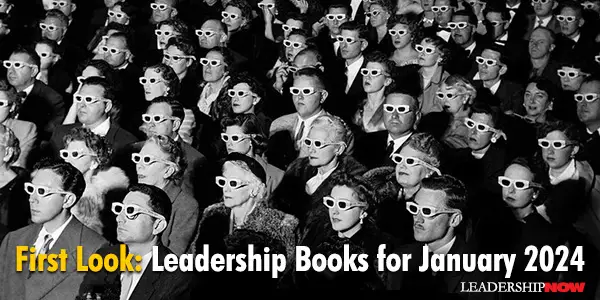
HERE'S A LOOK at some of the best leadership books to be released in January 2024 curated just for you. Be sure to check out the other great titles being offered this month.
It’s never been harder building successful teams. With challenges of work-from-anywhere, flex-schedule and generational divides, business leaders bend over backwards searching for solutions that work. They’ve tried everything from food perks and ping pong tables to endless team-building exercises and training—but nothing sticks. Now, in his long-awaited book for leaders at all levels, bestselling author Mike Michalowicz reveals his proven formula to build an unstoppable team for any work environment.
There are an estimated 200-500 million 1:1 meetings held each day around the world, but are they run as transformatively as they could be? Or are they just talk? In Glad We Met Rogelberg helps us maximize the potential of these crucial conversations. 1:1s are arguably one of the most critical meeting types for the success of team members, managers, coaches, teams, and organizations. The best managers recognize that 1:1s are not an add-on to their role as a manager. Conducting 1:1s successfully are foundational to being a manager. At the same time, these meetings are the core of a direct report's experience and development at work, including how well they engage and attach to their role, perceive the effectiveness of their manager, and envision their future at the organization.
There are moments when we achieve peak performance: An athlete plays a perfect game; a business has a quarter with once-in-a-lifetime profits. But these moments are often elusive, and for every amazing day, we may have a hundred ordinary and even unsatisfying days. Fulfillment doesn’t come from isolated peak experiences, but rather from many consistent good days. So how do we sustain performance, while avoiding burnout and maintaining balance? In Optimal, Daniel Goleman and Cary Cherniss reveal how emotional intelligence can help us have a great day, any day. They explain how to set a realistic, attainable goal of feeling satisfied that you’ve had a productive day — to consistently work at your ‘optimal’ level. Based on research of how hundreds of people build the inner architecture of having a good day, they sketch what an optimal state feels like, and show how emotional intelligence holds the key to our best performance.
Michael D. Watkins presents an actionable new framework to help aspiring leaders learn to think strategically—a set of skills more necessary than ever in a world of constant change. Pattern recognition. Systems perspective. Mental agility. Structured problem-solving. Visioning. Political savvy. For every good leader who has mastered of one of these disciplines is a great leader who knows and has mastered all of them. Watkins presents the six disciplines that separate the great from the good. Developed over the course of his storied career, Watkins’ approach to strategic thinking—"a set of mental disciplines leaders use to recognize potential threats and opportunities, establish priorities, and mobilize themselves and their organizations to envision and enact promising paths forward”—is the model followed by some of today’s most successful first-time CEOs and new business leaders.
Sometimes it seems that too many people are suffering from a crisis of identity, not sure what they stand for or what they want to do with their lives. The Goodwill Jar answers this problem. It teaches that when we focus on the good, offer the benefit of the doubt, and open our hearts to love, we can all live a richer life full of meaningful relationships. After all, humans are social creatures. Imagine what kind of world we would live in if everyone shared the goal of leaving others better than we found them. Follow the path of a typical person as they navigate the relationships that occur in every stage of life, from childhood to the grave. It starts with the foundational values of our youth, proceeds through those tumultuous teen years, on to early adulthood, mid-life, and finally ends at retirement. Every choice builds a legacy. Our leadership foundation begins when we are very young, setting the core values that drive choices for the rest of our lives. Once you know how to fill the goodwill jar of others, you can’t help but to live with a full goodwill jar yourself.
Every organization is plagued by destructive friction. Yet some forms of friction are incredibly useful, and leaders who attempt to improve workplace efficiency often make things even worse. Drawing from seven years of hands-on research, The Friction Project by bestselling authors Robert I. Sutton and Huggy Rao teaches readers how to become “friction fixers.” Sutton and Rao kick off the book by unpacking how skilled friction fixers think and act like trustees of others’ time. They provide friction forensics to help readers identify where to avert and repair bad organizational friction and where to maintain and inject good friction. Then their help pyramid shows how friction fixers do their work, from reframing friction troubles they can’t fix right now, so they feel less threatening, to designing and repairing organizations. The heart of the book digs into the causes and solutions for five of the most common and damaging friction troubles: oblivious leaders, addition sickness, broken connections, jargon monoxide, and fast and frenzied people and teams.
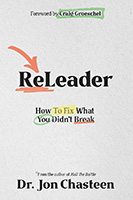 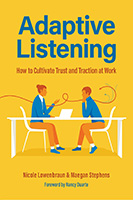 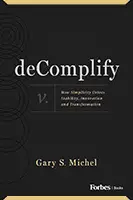 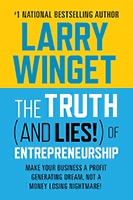
“... a mind needs books as a sword needs a whetstone, if it is to keep its edge.” — George R.R. Martin, A Game of Thrones
Posted by Michael McKinney at 04:11 PM
|
BUILD YOUR KNOWLEDGE


How to Do Your Start-Up Right STRAIGHT TALK FOR START-UPS 
Grow Your Leadership Skills NEW AND UPCOMING LEADERSHIP BOOKS 
Leadership Minute BITE-SIZE CONCEPTS YOU CAN CHEW ON 
Classic Leadership Books BOOKS TO READ BEFORE YOU LEAD |
|